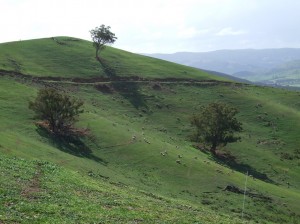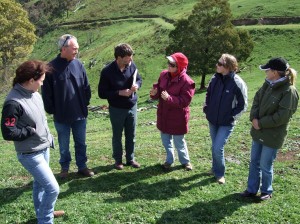Strath Creek Caring for Our Country EverGraze Supporting Site (Terry Hubbard)
Landclass fencing for management of steep hill country pastures.
- Case study – Paddock subdivision allows more strategic grazing, Terry Hubbard
- Final Report – Strath Creek Supporting Site
Fast Facts
Site Location: Strath Creek, Central Victoria
Host producer: Terry Hubbard
Producer group: Strath Creek Landcare Group
Site Coordinator: Peter Mitchell, Claire Wade, Agriculture Victoria
Duration: 2008-2011
Site focus
To improve persistence and productivity from native pastures on hill country by subdividing paddocks according to land class to enable more strategic grazing.
The Farm
Rainfall: 700 mm (average annual rainfall).
Enterprises: Sheep (2100 ewes) and cattle (155 breeding cows)
Farm area: 809 ha.
Soils: Friable gravel-based soils
The Site
A very steep 200 ha block was subdivided into six smaller blocks according to land class and aspect. Grazing was managed to improve persistence and productivity of native pastures. The site had a north and south face, divided along a ridge. The aim was to increase groundcover on the north-west face while increasing utilisation on the south face.
The steep north-west face was dominated by short-rooted annuals such as capeweed in the growing season, and was left mostly bare during summer with the exception of a few small tufts of wallaby grass scattered across the slope. Microlaena patches were evident in wetter areas further down the slope.
On the southern slopes, groundcover was maintained mostly by perennial ryegrass. The sheep did not utilise this area while the north-west slope was in the same paddock because it was cold and the pasture lost quality as it became rank.
|
|
|
Treatments
The strategy for the north slope was to include it in a rotational grazing system with rests of between 30 days during spring and 60 days during autumn and winter to increase the strength of the perennial component. A heavy graze during early spring to control capeweed before removing stock between November and the autumn break to allow native grasses to seed and germinate. No phosphorus fertiliser was applied to the north face to reduce the competitiveness of the capeweed compared with the native grasses. The aim was to maintain above 70 per cent groundcover throughout the year.
By dividing the two aspects, the sheep were forced to graze the southerly slope, hopefully increasing utilisation and feed quality. Using this area during early autumn would help create a feed wedge on areas more suitable for autumn lambing as the weather gets colder.
Measurements
The standard EverGraze Supporting Site Quickchecks protocol was implemented. Measurements were as follows:
- Pasture condition – availability (kg/ha), composition, ground cover, perennial species persistence (basal cover)
- Spring dry matter yield via hay cut
- Grazing days (DSE/ha) were recorded using the EverGraze Feedbase Planning and Budgeting Tools.
- Soil testing
Key Results
- Rainfall at the site was low in 2008 and this was followed by a fairly normal season in 2009 and high summer rainfall events in 2010 and 2011.
- Higher summer rainfall, combined with summer rests, enabled significant increases in perennial basal cover, consistent with Proof Sites at Chiltern, Holbrook and Orange, and Supporting Sites at Murmungee, Tallangatta Valley and Warrak.
- Paddock subdivision enabled ground cover targets (90%) to be reached in both north and south facing paddocks.
A full set of results, graphs and images can be found in the Strath Creek final report.
Acknowledgements
The Strath Creek Supporting Site was funded by the National Landcare Program, Caring for Our Country, the Agriculture Victoria, Central Highlands Agribusiness Forum and the Future Farm Industries CRC through the National EverGraze Project.
Further Information
- Paddock subdivision allows more strategic grazing – Terry Hubbard, Three Sisters
- EverGraze Action – Dividing up the farm for grazing management
- EverGraze Exchange – The nuts and bolts of grazing strategies
- Native pastures for sustainable agriculture (identification brochure)
- EverGraze Action – Managing native pastures in Victoria
- Orange EverGraze research message – Landscape can be identified, mapped and managed
- Chiltern EverGraze research message – Composition and production from native pastures in response to fertiliser and grazing



